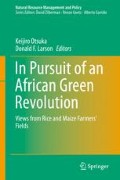Abstract
Observing clear upward trend in rice yield in SSA, this volume attempted to explore whether Green Revolution in rice has taken place in irrigated areas in sub-Saharan Africa (SSA), whether it is possible to realize a rice Green Revolution in rainfed areas, and the extent to which technology and management training has been effective in dissemination of Green Revolution technology. We then looked for signs of significant changes in maize yield from farmers’ fields, particularly from highly populated highlands of Kenya. To our surprise, many maize farmers in Kenya adopt land-saving and labor-intensive maize-livestock mixed systems, consistent with the Boserupian theory of agricultural intensification . But institutional innovations from the public sector, such as the support for agricultural research on the establishment of new maize-based farming system s and extension, have not taken place, thereby limiting major gains in maize yields in many areas of SSA.
Access this chapter
Tax calculation will be finalised at checkout
Purchases are for personal use only
Notes
- 1.
Since JICA training area was not chosen randomly, the reported higher yield cannot be solely attributed to the impact of the training program.
- 2.
- 3.
Climate is fine and dry in this valley, which facilitates photo-synthesis and prevents outbreak of pests. Since it is basin of Senegal River, water is abundant and soil is fertile.
- 4.
Basmti is high-quality and relatively low-yielding varieties. In some areas of Mwea irrigation scheme where IRRI-type modern varieties are grown, yields are as high as 8 tons per hectare.
- 5.
Kilombero is rainfed and flood-prone area due to runoff water from nearby mountain range, and the soil is very fertile.
- 6.
Note that cheap credit was provided to participants in the training program in Ghana initially as well as in Kilombero Valley at present.
- 7.
Although evidence is weak, rice farmers in Asia seem to have known the importance of bunding and leveling of paddy fields even before the Green Revolution . Straight-row transplanting, however, was disseminated with the introduction of MVs in the 1970s.
References
Balasubramanian V, Sie M, Hijmans RJ, Otsuka K (2007) Increasing rice production in sub-Saharan Africa: challenges and opportunities. Adv Agron 94(1):55–133
Buresh RJ (2015) Nutrient and fertilizer management in rice systems with varying supply of water. In: Drechsel P, Heffer P, Magen H, Mikkelsen R, Wichelns D (eds) Managing water and fertilizer for sustainable agricultural intensification. IFA/IWMI/IPNI/IPI Publication, Paris
David CC, Otsuka K (1994) Modern rice technology and income distribution in Asia. Lynne Rienner, Boulder
Haggblade S, Hazell PBR (2010) Successes in African agriculture: lessons for the future. Johns Hopkins University Press, Baltimore
Hayami Y, Ruttan VW (1985) Agricultural development: an international perspective. Johns Hopkins University Press, Baltimore
Johnston BF, Cownie J (1969) The seed-fertilizer revolution and labor force absorption. Am Econ Rev 59(4):569–582
Ladha JK, Reddy PM (2003) Nitorgen fixation in rice systems: state of knowledge and future prospects. Plant Soil 252(1):151–167
Nakano Y, Otsuka K (2011) Determinants of household contributions to collective irrigation management: the case of the Doho rice scheme in Uganda. Environ Dev Econ 16(5):527–551
Nakano Y, Tanaka Y, Otsuka K (2015) To what extent does modified SRI increase productivity of small-scale rice cultivation in rain-fed area?: evidence from Tanzania, mimeo, National Graduate Institute for Policy Studies
Njeru TN, Mano Y, Otsuka K (2014) Role of access to credit in rice production in sub Saharan Africa: the case of Mwea irrigation scheme in Kenya, mimeo, National Graduate Institute for Policy Studies
Otsuka K, Larson DF (2013b) An African Green Revolution: finding ways to boost productivity on small farms. Springer, Dordrecht
Quizon JB, Binswanger HP (1983) Income distribution in agriculture: a unified approach. Am J Agri Econ 65(3):526–538
Author information
Authors and Affiliations
Corresponding author
Editor information
Editors and Affiliations
Rights and permissions
Copyright information
© 2016 The Editor(s) and the Author(s)
About this chapter
Cite this chapter
Otsuka, K., Larson, D.F. (2016). Conclusions: Strategies Towards a Green Revolution in Sub-Saharan Africa. In: Otsuka, K., Larson, D. (eds) In Pursuit of an African Green Revolution. Natural Resource Management and Policy, vol 48. Springer, Tokyo. https://doi.org/10.1007/978-4-431-55693-0_9
Download citation
DOI: https://doi.org/10.1007/978-4-431-55693-0_9
Publisher Name: Springer, Tokyo
Print ISBN: 978-4-431-55692-3
Online ISBN: 978-4-431-55693-0
eBook Packages: Economics and FinanceEconomics and Finance (R0)

